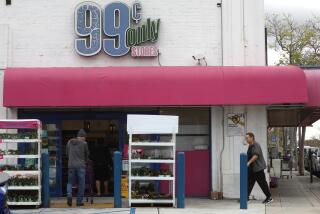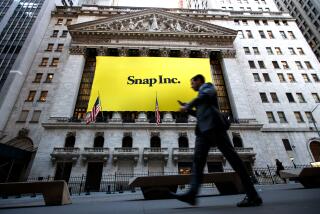Gap Fails to Cash In as Holiday Pricing Tactic Falls Short
- Share via
When Cosset Arana went Christmas shopping, she stopped in at a Gap and left empty-handed.
“They didn’t have good sales,” said Arana, 35, an office administrator from Los Angeles. She found prices that pleased her at Robinsons-May and JCPenney.
A lot of people took a pass on Gap stores during the holiday season. While year-over-year shopping mall traffic was down 1% in December -- the most important month for retailers -- traffic in Gap Inc.’s 4,200 Gap, Old Navy and Banana Republic stores was 6% lower. And Gap’s same-store sales in December rose just 1%, compared with the 5% uptick they registered a year earlier.
Investors reacted by hammering the stock, and some analysts trimmed quarterly expectations.
The San Francisco-based company “was clearly the biggest disappointment of the month,” Brian Tunick, an analyst with JP Morgan Securities, said in a report released Friday.
Gap spokeswoman Stacy MacLean said the company was taking the stumble in stride. “This is one month of many,” she said. “We were pleased with the momentum of the company and still are.”
In fact, many analysts said December’s weaker-than-expected results weren’t necessarily bad news for the nation’s largest specialty retailer. Robert Buchanan, with A.G. Edwards & Sons, said December wasn’t “a disaster by any means,” adding that Gap should “still have a nice increase in profits” in the company’s fourth quarter.
Adrienne Tennant, with Wedbush Morgan Securities, judged Gap’s turnaround from the bleak days of recent years “well underway.”
“Like any turnaround,” she said, “it’s a slow process.”
Since October 2002 -- when a streak of 29 consecutive months of declining same-store sales ended -- Gap has seen that statistic remain positive. Same-store sales are viewed as a key indicator of a retailer’s health because they are a tally from established stores, open for at least one year.
The disappointing December may be a result of a decision by Gap to keep a tight control on inventory and focus on profit, rather than try to drive sales by plastering “sale” signs throughout the store all season. Though the tactic can be nerve-racking for investors when short-term results fall short of estimates, it can be a winning strategy in the end.
In December, though, it didn’t suit Cindy Terry. Her 14-year-old daughter loved the brightly colored scarfs that Gap was selling before Christmas for about $25.
“It was just too expensive,” Terry said as she shopped a sale rack Saturday at the Gap at Triangle Square in Costa Mesa. “You could go to other places and the scarf was, like, 10 bucks.”
But Gap said the strategy had reaped rewards: The average amount paid for a product in its namesake stores increased in December from the prior year, helping offset the drop in traffic. Gap squeezed higher margins from its merchandise, both at marked-down and full prices.
In December, Gap’s same-store sales were flat in the U.S. compared with the prior year, while at Gap International they fell 3%. Much of Wall Street’s attention focuses on the company’s flagship chain, which is considered the key piece of the turnaround puzzle.
Banana Republic, the company’s priciest division, logged a 10% sales gain while Old Navy nudged up 2%. Overall, the company’s same-store sales didn’t climb nearly the 5.1% expected by analysts polled by Thomson First Call.
“This is probably the first time they’ve missed what people were expecting of them” since Gap began posting the string of positive sales results, Tenant said.
After the December sales numbers were released Thursday, investors lopped $3, or 13%, off the price of the retailer’s stock. Gap slipped an additional 15 cents Friday to $19.85 on the New York Stock Exchange.
Some analysts said Wall Street had gotten overly bullish about Gap’s quarterly prospects without the benefit of any guidance from management. Some have taken a cautious approach to the rating of Gap’s stock, saying that improvements the company has made over the last year -- including weeding its real estate portfolio, better managing its supply chain and introducing technology that helps determine when to mark down merchandise -- was already factored into the price of the company’s stock.
Todd Slater, with Lazard Freres & Co., downgraded the stock to a “hold” from a “buy” on Thursday.
“Gap has made excellent merchandising and operating improvements in the last 18 months, but trends will become challenging in 2004 against increasingly difficult sales and margin comparisons,” his report said.
Some Gap watchers said the company still had considerable work to do to prove that it could sustain a solid, long-term turnaround.
“I just think they lack focus,” Buchanan said. “I think they will fail if they continue to try to be all things to all people.”
As for the disappointing December, observers said there were no doubt several factors behind it.
Though the retailer made a splash in 2002 with its sweaters, scarfs and hats with crazy stripes, analysts said it couldn’t duplicate that success with the brightly colored offerings of 2003, perhaps because people wanted only so much of that sort of thing in their closets. Further, Gap outdid competitors with its sweater offerings in 2002, but last year similar sweaters were everywhere.
More to Read
Inside the business of entertainment
The Wide Shot brings you news, analysis and insights on everything from streaming wars to production — and what it all means for the future.
You may occasionally receive promotional content from the Los Angeles Times.










